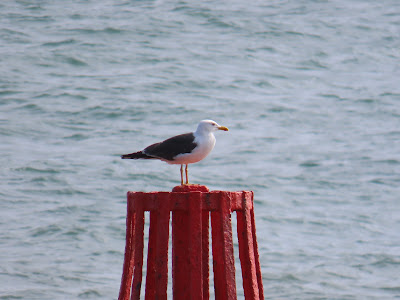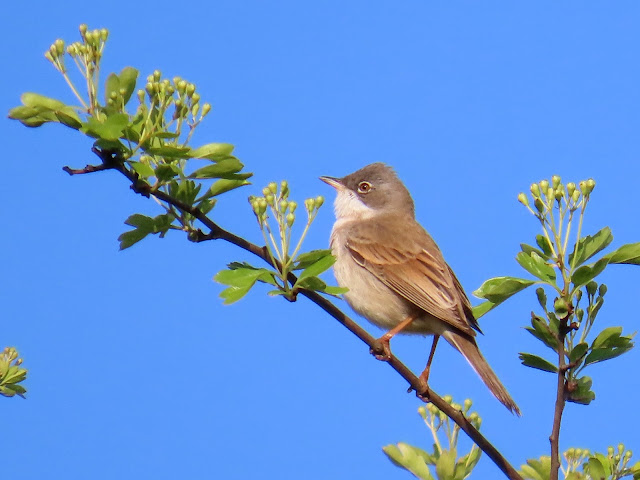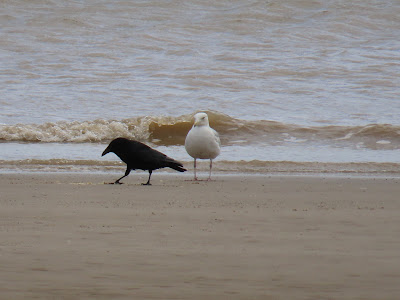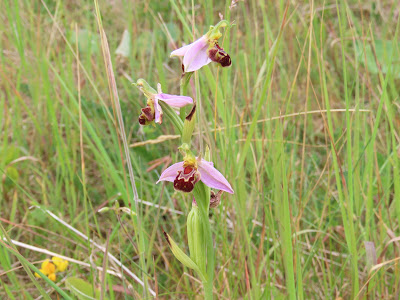
I have done all, or parts, of this walk in the past: in May 2020 as part of the
Migrants Way, when I was lucky enough to explore first hand the ancient submarine forest at Sand-le-Mere. Then in December same year, when we went to see the
stranded Sperm Whales along this section of the beach. I wanted to avoid visiting the coastal towns and villages I've visited before for this Holderness Walks series, but it is hard to avoid the sea breeze when a heat wave is raging inland. I took the 8:00 X7 bus to Withernsea, the temperature was already hitting 20 oC as I walked to the station. I'm a bit early and the tide is still flowing, so I walk around the town, exploring St Nicholas church, which appears to be
closed and being refurbished. The churches at Withernsea have had a rough time through history, this one was built in the 15th century to replace the Church of St Mary's, lost to coastal erosion. Withernsea (or should I say New Withernsea, the old one a casualty of erosion too) had a great spurt of development after the arrival of the railway, and the survival of this church, which lay in ruins for 200 years, is partly due to investment by the owners of the railway, which wanted to enhance the town for tourism reasons.
The sea breeze is wonderfully cool, aided by a southerly wind. It is also nice to walk north on a sunny day like this. The town is busy with Swifts, House Martins and Swallows. Most Herring Gulls have young, their plaintive, whistling begging calls coming from their nests in chimneys and roofs. I'm careful not to stare at the young, as the parents are very wary and will start alarming, after the most minor of motives.
Lesser Black-backed Gull.
Herring Gulls with their young.
St Nicholas Church.
A detail of the walls, made of cobbles and pebbles, the most easily available material.
Young starlings, some already moulting into their adult plumage.
Withernsea Lighthouse.
A Swallow looks to other swallows perched on an aerial above.
Young Swallows.
House Martin in its nest.
Comma.
Owthorne Walk.
On the North side of Withernsea sat the village of Owthorne, in the mid 19th century, before the railway arrived, it was larger than Withernsea. Today it has been subsumed by Withernsea, it is effectively an area in Withernsea. Its name survives in a footpath and a street, Owthorne Walk, leading to the sea. After exploring the walk, and ticking off Owthorne, which I had included in my list of villages, I take the promenade heading North, and then descend the steps onto the beach. The tide is now low enough and there is a wide sandy beach. The sea defences of Withernsea mean that sand collects north of the town. The effects of this is clear, the cliffs are more sheltered from erosion and there is a higher sandy beach that appears not to flood at high tide. Sea Rocket is colonising the strandline, with some young plants of this year. Unfortunately the plants are affected by some parasite and there are no flowers. Sand Martins and House Martins fly along the beach. I notice House Martins flying around a seepage and wonder if they are collecting mud from it. I hear two Meadow Pipits displaying above and flush a couple of Linnets.

Meadow Pipit.
A Black-headed Gull resting on the beach.
A Sand Martin chases an insect.
Sand Martin colony.
Sand Martin.
Sand Martin flying around its colony.

The tide hasn't exposed a small stretch of beach in the horizon, by Waxholme, but it's only a matter of minutes. I linger around it and cross it as soon as a wave recedes. I almost bump onto a couple with a dog, who are walking in the opposite direction, as we cross at this pinch point. The beach rises and widens again quickly after this, and there are shingle banks and hollows off the cliffs. The cliff is rapidly reducing in height, until I get to Sand-le-Mere, where there is no cliff, there is an opening and a slope (top shot). A few years ago there was a boatyard, but there are no boats today. Sandwich Terns call from far offshore and a flock of Shelduck fly against the wind, and then decide to alight on the sea. I walk on the rapidly eroding bank separating the sea from the low lying fields to the west, part of the basin of a lost mere, Sand-le-Mere ('Sandley Marr' in Jeffrey's 1771 map). This bank is no longer repaired and has large gaps. Tunstall Drain takes water to the west too, ending in Keyingham Drain and Stony Creek in the Humber. A managed realignment scheme protects the road itself, eventually letting the remaining basin of the mere being flooded again at spring tides and storms.

Shelduck.
The coastal path has been diverted inland here, across the caravan park of Sand-le-Mere. I take it, lingering on the several lakes of the park, and eventually find a shady spot by a lake to have my lunch. If it had been cooler I would have carried on to Tunstall, but its the middle of the day and much warmer inland. I watch the waterfowl and record some dragonflies before catching the bus back to Withernsea, and then home.
Red Admiral.
Swift over Sand-le-Mere.
Black-tailed Skimmer.
Mute Swans and cygnets.


























.JPG)
























